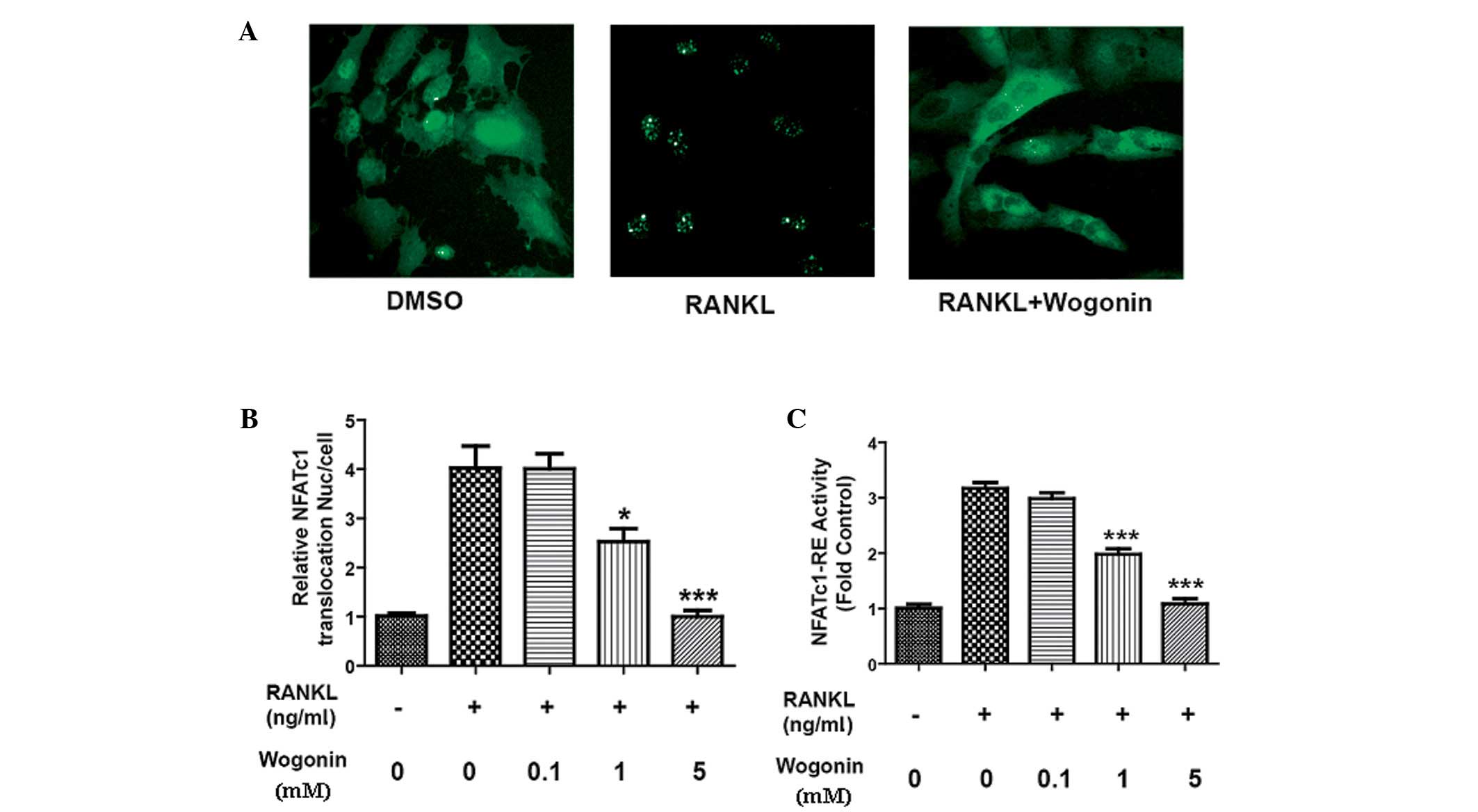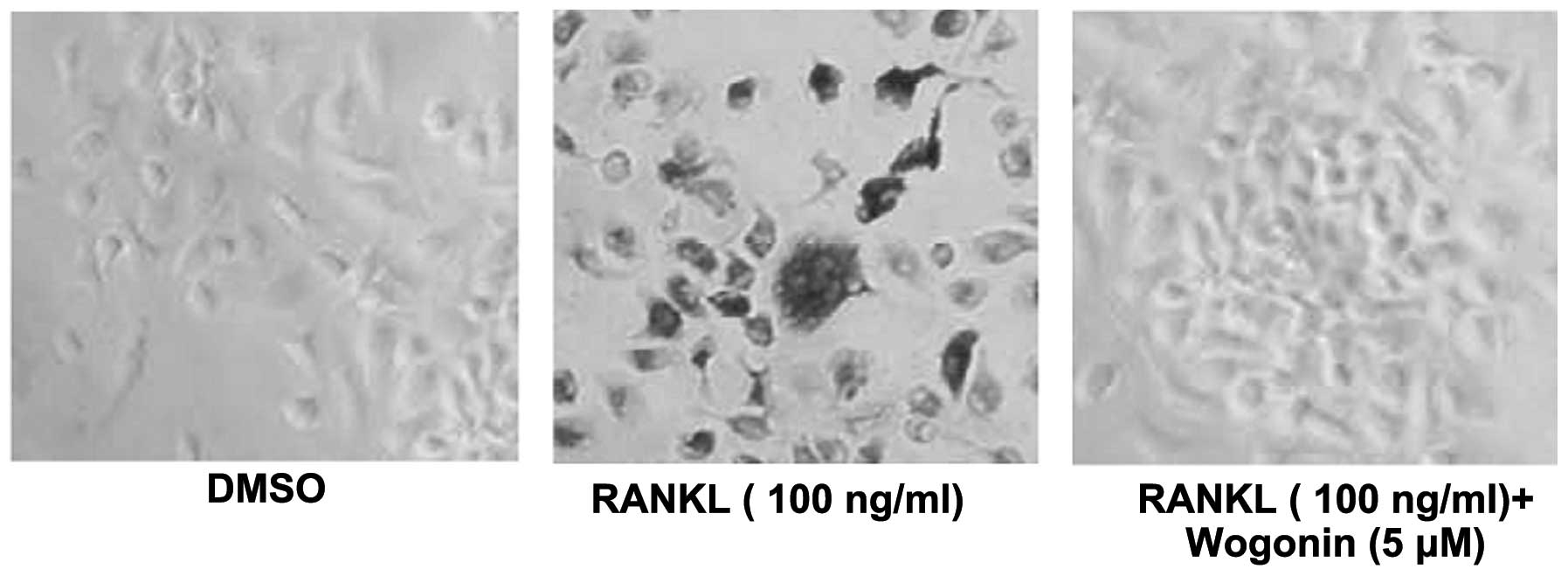|
1
|
Zaidi M: Skeletal remodeling in health and
disease. Nat Med. 13:791–801. 2007. View
Article : Google Scholar : PubMed/NCBI
|
|
2
|
Novack DV and Teitelbaum SL: The
osteoclast: Friend or foe? Annu Rev Pathol. 3:457–484. 2008.
View Article : Google Scholar : PubMed/NCBI
|
|
3
|
Horsley V, Aliprantis AO, Polak L,
Glimcher LH and Fuchs E: NFATc1 balances quiescence and
proliferation of skin stem cells. Cell. 132:299–310. 2008.
View Article : Google Scholar : PubMed/NCBI
|
|
4
|
Pei J, Li B, Gao, et al: Fluoride
decreased osteoblastic bone resorption through the inhibition of
NFATc1 gene expression. Environ Toxicol. 29:588–595. 2014.
View Article : Google Scholar : PubMed/NCBI
|
|
5
|
Negishi-Koga T and Takayanagi H:
Ca2+-NFATc1 signaling is an essential axis of osteoclast
differentiation. Immunol Rev. 231:241–256. 2009. View Article : Google Scholar : PubMed/NCBI
|
|
6
|
Takayanagi H, Kim S, Koga T, et al:
Induction and activation of the transcription factor NFATc1 (NFAT2)
integrate RANKL signaling in terminal differentiation of
osteoclasts. Dev Cell. 3:889–901. 2002. View Article : Google Scholar : PubMed/NCBI
|
|
7
|
Kim K, Kim JH, Lee J, et al: Nuclear
factor of activated T cells c1 induces osteoclast-associated
receptor gene expression during tumor necrosis factor-related
activation-induced cytokine-mediated osteoclastogenesis. J Biol
Chem. 280:35209–35216. 2005. View Article : Google Scholar : PubMed/NCBI
|
|
8
|
Kim Y, Sato K, Asagiri M, Morita I, Soma K
and Takayanagi H: Contribution of nuclear factor of activated T
cells c1 to the transcriptional control of immunoreceptor
osteoclast-associated receptor but not triggering receptor
expressed by myeloid cells-2 during osteoclastogenesis. J Biol
Chem. 280:32905–32913. 2005. View Article : Google Scholar : PubMed/NCBI
|
|
9
|
He L, Lu N, Dai Q, et al: Wogonin induced
G1 cell cycle arrest by regulating Wnt/β-catenin signaling pathway
and inactivating CDK8 in human colorectal cancer carcinoma cells.
Toxicology. 312:36–47. 2013. View Article : Google Scholar : PubMed/NCBI
|
|
10
|
Chen XM, Bai Y, Zhong YJ, et al: Wogonin
has multiple anti-cancer effects by regulating c-Myc/SKP2/Fbw7α and
HDAC1/HDAC2 pathways and inducing apoptosis in human lung
adenocarcinoma cell line A549. PLoS One. 8:e792012013. View Article : Google Scholar : PubMed/NCBI
|
|
11
|
Masuda ES, Imamura R, Amasaki Y, Arai K
and Arai N: Signalling into the T-cell nucleus: NFAT regulation.
Cell Signal. 10:599–611. 1998. View Article : Google Scholar : PubMed/NCBI
|
|
12
|
Collin-Osdoby P and Osdoby P:
RANKL-mediated osteoclast formation from murine RAW 264.7 cells.
Methods Mol Biol. 816:187–202. 2012. View Article : Google Scholar : PubMed/NCBI
|
|
13
|
Kim SJ, Ding W, Albrecht B, Green PL and
Lairmore MD: A conserved calcineurin-binding motif in human T
lymphotropic virus type 1 p12I functions to modulate nuclear factor
of activated T cell activation. J Biol Chem. 278:15550–15557. 2003.
View Article : Google Scholar : PubMed/NCBI
|
|
14
|
Ikeda F, Nishimura R, Matsubara T, et al:
Critical roles of c-Jun signaling in regulation of NFAT family and
RANKL-regulated osteoclast differentiation. J Clin Invest.
114:475–484. 2004. View Article : Google Scholar : PubMed/NCBI
|
|
15
|
Ikeda F, Nishimura R, Matsubara T, Hata K,
Reddy SV and Yoneda T: Activation of NFAT signal in vivo leads to
osteopenia associated with increased osteoclastogenesis and
bone-resorbing activity. J Immunol. 177:2384–2390. 2006. View Article : Google Scholar : PubMed/NCBI
|
|
16
|
Xu M, Lu N, Zhang H, et al: Wogonin
induced cytotoxicity in human hepatocellular carcinoma cells by
activation of unfolded protein response and inactivation of AKT.
Hepatol Res. 43:890–905. 2013. View Article : Google Scholar : PubMed/NCBI
|
|
17
|
Chow SE, Chen YW, Liang CA, Huang YK and
Wang JS: Wogonin induces cross-regulation between autophagy and
apoptosis via a variety of Akt pathway in human nasopharyngeal
carcinoma cells. J Cell Biochem. 113:3476–3485. 2012. View Article : Google Scholar : PubMed/NCBI
|
|
18
|
Wang W, Guo QL, You QD, et al: The
anticancer activities of wogonin in murine sarcoma S180 both in
vitro and in vivo. Biol Pharm Bull. 29:1132–1137. 2006. View Article : Google Scholar : PubMed/NCBI
|
|
19
|
Zhang HW, Yang Y, Zhang K, et al: Wogonin
induced differentiation and G1 phase arrest of human U-937 leukemia
cells via PKCD phosphorylation. Eur J Pharmacol. 591:7–12. 2008.
View Article : Google Scholar : PubMed/NCBI
|
|
20
|
Baumann S, Fas SC, Giaisi M, et al:
Wogonin preferentially kills malignant lymphocytes and suppresses
T-cell tumor growth by inducing PLCC1-and Ca2+-dependent
apoptosis. Blood. 111:2354–2363. 2008. View Article : Google Scholar : PubMed/NCBI
|
|
21
|
Tsai CF, Yeh WL, Huang SM, Tan TW and Lu
DY: Wogonin induces reactive oxygen species production and cell
apoptosis in human glioma cancer cells. Int J Mol Sci.
13:9877–9892. 2012. View Article : Google Scholar : PubMed/NCBI
|












